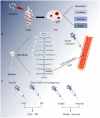Role of serum neuron-specific enolase levels in the early diagnosis and prognosis of sepsis-associated encephalopathy: a systematic review and meta-analysis
- PMID: 38685952
- PMCID: PMC11057363
- DOI: 10.3389/fneur.2024.1353063
Role of serum neuron-specific enolase levels in the early diagnosis and prognosis of sepsis-associated encephalopathy: a systematic review and meta-analysis
Abstract
Background: Sepsis-associated encephalopathy (SAE) is one of the most ubiquitous complications of sepsis and is characterized by cognitive impairment, poor prognosis, and a lack of uniform clinical diagnostic criteria. Therefore, this study investigated the early diagnostic and prognostic value of serum neuron-specific enolase (NSE) in SAE.
Methods: This systematic review and meta-analysis systematically searched for clinical trials with serum NSE information in patients with sepsis in the PubMed, Web of Science, Embase, and Cochrane databases from their inception to April 10, 2023. Included studies were assessed for quality and risk of bias using The Quality Assessment of Diagnostic Accuracy-2 tool. The meta-analysis of the included studies was performed using Stata 17.0 and Review Manager version 5.4.
Findings: Eleven studies were included in this meta-analysis involving 1259 serum samples from 947 patients with sepsis. Our results showed that the serum NSE levels of patients with SAE were higher than those of the non-encephalopathy sepsis group (mean deviation, MD,12.39[95% CI 8.27-16.50, Z = 5.9, p < 0.00001]), and the serum NSE levels of patients with sepsis who died were higher than those of survivors (MD,4.17[95% CI 2.66-5.68, Z = 5.41, p < 0.00001]).
Conclusion: Elevated serum NSE levels in patients with sepsis are associated with the early diagnosis of SAE and mortality; therefore, serum NSE probably is a valid biomarker for the early diagnosis and prognosis of patients with SAE.
Systematic review registration: This study was registered in PROSPERO, CRD42023433111.
Keywords: biomarker; meta-analysis; neuron-specific enolase; sepsis-associated encephalopathy; serum.
Copyright © 2024 Pei, Yang, Zhang, Huang, Fang, Xu, Lin and He.
Conflict of interest statement
The authors declare that the research was conducted in the absence of any commercial or financial relationships that could be construed as a potential conflict of interest.
Figures










Similar articles
-
Meta-analysis of evaluating neuron specific enolase as a serum biomarker for sepsis-associated encephalopathy.Int Immunopharmacol. 2024 Apr 20;131:111857. doi: 10.1016/j.intimp.2024.111857. Epub 2024 Mar 14. Int Immunopharmacol. 2024. PMID: 38489973
-
Clinical value of serum neuron-specific enolase in sepsis-associated encephalopathy: a systematic review and meta-analysis.Syst Rev. 2024 Jul 22;13(1):191. doi: 10.1186/s13643-024-02583-4. Syst Rev. 2024. PMID: 39039544 Free PMC article.
-
Can serum NSE predict and evaluate sepsis-associated encephalopathy: A protocol for a systematic review and meta-analysis.J Clin Neurosci. 2024 Jun;124:150-153. doi: 10.1016/j.jocn.2024.04.029. Epub 2024 May 7. J Clin Neurosci. 2024. PMID: 38718610 Review.
-
Unveiling neurogenic biomarkers for the differentiation between sepsis patients with or without encephalopathy: an updated meta-analysis.Syst Rev. 2025 Feb 8;14(1):38. doi: 10.1186/s13643-025-02784-5. Syst Rev. 2025. PMID: 39923061 Free PMC article.
-
Diagnostic and prognostic value of serum S100B in sepsis-associated encephalopathy: A systematic review and meta-analysis.Front Immunol. 2023 Jan 27;14:1102126. doi: 10.3389/fimmu.2023.1102126. eCollection 2023. Front Immunol. 2023. PMID: 36776893 Free PMC article.
Cited by
-
The Role of Ultrasonographic Assessment of Optic Nerve Sheath Diameter in Prediction of Sepsis-Associated Encephalopathy: Prospective Observational Study.Neurocrit Care. 2025 Aug;43(1):308-317. doi: 10.1007/s12028-024-02187-9. Epub 2025 Jan 15. Neurocrit Care. 2025. PMID: 39815108 Free PMC article.
-
The prediction value of serum anion gap for short-term mortality in pulmonary hypertension patients with sepsis: a retrospective cohort study.Front Med (Lausanne). 2025 Jan 7;11:1499677. doi: 10.3389/fmed.2024.1499677. eCollection 2024. Front Med (Lausanne). 2025. PMID: 39839613 Free PMC article.
-
Clinical value of the lactate-to-albumin ratio in assessing prognosis in critically ill patients with sepsis-associated encephalopathy: A retrospective analysis.Sci Prog. 2025 Jul-Sep;108(3):368504251371107. doi: 10.1177/00368504251371107. Epub 2025 Aug 18. Sci Prog. 2025. PMID: 40827023 Free PMC article.
-
Review on the Role of Mitochondrial Dysfunction in Septic Encephalopathy.Cell Biochem Biophys. 2025 Mar;83(1):135-145. doi: 10.1007/s12013-024-01493-5. Epub 2024 Aug 30. Cell Biochem Biophys. 2025. PMID: 39212823 Review.
References
Publication types
LinkOut - more resources
Full Text Sources
Miscellaneous

